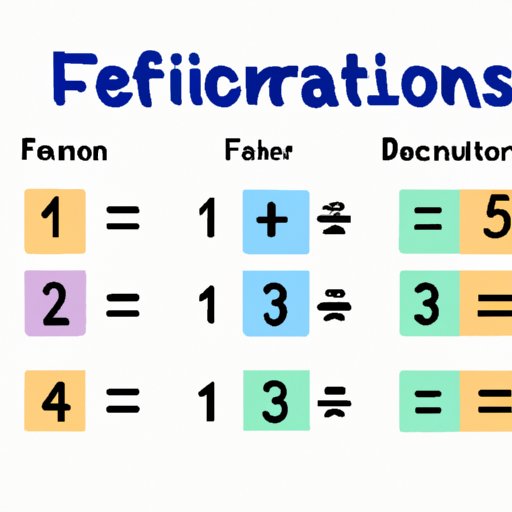Introduction
Fractions are a fundamental part of mathematics and everyday life. They represent parts of whole numbers and are used in various applications, such as cooking, woodworking, engineering, and finance. Knowing how to compare fractions is an essential skill that can be used to solve many real-life problems. In this article, we’ll explore different techniques you can use to compare fractions and understand which is bigger.
The Bigger Fraction: How to Compare Fractions and Determine Size
To compare fractions, you need to understand that fractions are expressed using two components: the numerator and the denominator. The numerator represents the number of parts you have, and the denominator represents the total number of parts that make up the whole. Fractions can be compared and ordered from smallest to largest, and vice versa. Here are some ways to compare fractions:
Compare fractions with the same denominator
If two fractions have the same denominator, the fraction with the larger numerator is the larger fraction. For example, if you have 1/4 and 3/4, the fraction with the larger numerator, 3/4, is the bigger fraction.
Compare fractions with the same numerator
If two fractions have the same numerator, the fraction with the smaller denominator is the larger fraction. For example, if you have 2/5 and 2/7, the fraction with the smaller denominator, 2/5, is the bigger fraction.
Compare fractions with different denominators and numerators
When comparing fractions with different denominators and numerators, you need to find a common denominator to make the comparison. There are different ways to find a common denominator, such as by multiplying the denominators or finding the least common multiple. Once the fractions have a common denominator, you can compare the numerators to determine which is greater.
From Numerator to Denominator: Tips for Comparing Fractions and Finding the Bigger Value
Understanding the relationship between the numerator and denominator is crucial to comparing fractions and finding the bigger value.
Understanding the relationship between the numerator and denominator
The numerator represents the number of parts you have, while the denominator represents the total number of parts that make up the whole. To visualize this relationship, think of a pizza divided into eight equal slices. If you have three slices, the fraction representing this would be 3/8, where 3 is the number of slices you have, and 8 is the total number of slices in the pizza.
Converting fractions to equivalent fractions with common denominators
When comparing fractions with different denominators, you need to convert them to equivalent fractions with common denominators. You can do this by finding a common multiple of the denominators and multiplying each fraction by an appropriate factor. For example, to compare 1/3 and 2/5, you can find a common denominator, which is 15, and convert the fractions to 5/15 and 6/15. Then, you can compare the numerators, and the larger fraction is 6/15.
Fraction Comparison: A Step-by-Step Guide to Deciding Which is Larger
Here’s a step-by-step guide on how to compare fractions and decide which is larger:
Step 1: Convert fractions to equivalent fractions with common denominators
If the fractions have different denominators, convert them to equivalent fractions with common denominators by finding a common multiple of the denominators and multiplying each fraction by an appropriate factor.
Step 2: Compare the numerators of the fractions
Once the fractions have the same denominator, you can compare their numerators. The fraction with the larger numerator is the bigger fraction.
Step 3: Determine which fraction is greater
After comparing the numerators, you can determine which fraction is greater.
A Visual Approach to Determining Which Fraction is Bigger
Visual models can be used to compare fractions and help you understand which fraction is larger.
Using a number line to compare fractions
You can use a number line to compare fractions and determine which is greater. For example, to compare 1/4 and 3/5, you can plot them on the number line between 0 and 1, with common denominators. Then, you can see that 3/5 is greater than 1/4 because it is closer to 1.
Using visual models (e.g. fraction bars, pies) to compare fractions
Visual models, such as fraction bars or pies, can help you visualize the relationship between the numerator and denominator of a fraction and compare fractions. For example, to compare 2/3 and 3/4, you can use fraction bars or pies to represent the fractions and see that 3/4 is bigger than 2/3 because it covers a larger portion of the whole.
Mastering Fraction Comparison: Techniques for Finding the Greater Value
Here are some techniques you can use to find the greater value when comparing fractions:
Simplifying fractions before comparing them
You can simplify fractions before comparing them to make the process easier. To simplify a fraction, divide both the numerator and denominator by their greatest common factor (GCF). For example, to simplify 6/8, you can divide both 6 and 8 by 2 to get 3/4.
Cross-multiplying to compare fractions with different denominators
Cross-multiplying is a technique used to compare fractions with different denominators. To cross-multiply, multiply the numerator of one fraction by the denominator of the other, and compare the products. For example, to compare 1/3 and 2/5, you can cross-multiply to get 5/15 and 6/15, respectively. Then, you can compare the numerators, and the larger fraction is 6/15.
Conclusion
Comparing fractions is an essential skill that can help you solve various real-life problems, such as determining the cheapest price per unit, calculating the percentage of a discount, or dividing a recipe. Understanding the relationship between the numerator and denominator, using common denominators, and mastering different techniques can help you compare fractions and determine the bigger value. Whether you use a visual approach, a step-by-step guide, or a combination of techniques, remember that practice makes perfect, and with time and effort, you can become proficient in comparing fractions.
